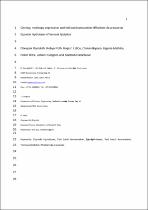 ResearchSpace
ResearchSpace
Cloning, multicopy expression and fed-batch production of Rhodotorula araucariae epoxide hydrolase in yarrowia lipolytica
JavaScript is disabled for your browser. Some features of this site may not work without it.
- ResearchSpace
- →
- Research Publications/Outputs
- →
- Journal Articles
- →
- View Item
| dc.contributor.author |
Ramduth, D

|
|
| dc.contributor.author |
Roth, Robyn L

|
|
| dc.contributor.author |
Lalloo, Rajesh

|
|
| dc.contributor.author |
Simpson, C

|
|
| dc.contributor.author |
Mitra, RK

|
|
| dc.contributor.author |
Gorgens, J

|
|
| dc.contributor.author |
Ramchuran, Santosh O

|
|
| dc.contributor.author |
Mathiba, K

|
|
| dc.date.accessioned | 2009-05-07T11:03:06Z | |
| dc.date.available | 2009-05-07T11:03:06Z | |
| dc.date.issued | 2008-05 | |
| dc.identifier.citation | Ramduth, D, Roth, RL, Lalloo, R et al. 2008. Cloning, multicopy expression and fed-batch production of rhodotorula araucariae epoxide hydrolase in yarrowia lipolytica. Applied Microbiology and Biotechnology, Vol.(2008), pp 27 | en |
| dc.identifier.issn | 0175-7598 | |
| dc.identifier.uri | http://hdl.handle.net/10204/3352 | |
| dc.description | This is the author's version of the work. It is posted here by permission of Springer Verlag for your personal use. Not for redistribution | en |
| dc.description.abstract | Epoxide hydrolases (EHs) of fungal origin have the ability to catalyse the enantioselective hydrolysis of epoxides to their corresponding diols. However wild type fungal EHs are limited in the substrate range and enantioselectivity, additionally wild type fungal EH productivities are relatively low. Recombinant DNA technology has been previously used to overproduce these enzymes in expression systems such as E. coli and A.niger and P. pastoris. EH encoding genes from Rhodotorula araucariae were cloned and functionally expressed in Y. lipolytica, under the control of a growth inducible hp4d promoter. The transformation experiments yielded only two positive multicopy transformants, which were assessed in flask cultures. The selected transformant demonstrated a 4 fold enhanced EH activity over the transformant. The transformant was then evaluated in batch and fed batch fermentations, where the batch fermentations resulted in - 50% improved EH activity from flask evaluations. In fed batch fermentations, different specific feed rates were tested. A specific feed rate of 0.1 g.g-1.h-1 resulted in the highest EH activity of 1750 mU.mg dw-1, compared to maximum production levels of 0.3 mU.mg dw-1 for the wild type R. araucariae and 52 mU.mg dw-1 E. coli. A 2.7-fold increase was observed from shake-flask fermentation to the fed-batch fermentation | en |
| dc.language.iso | en | en |
| dc.publisher | Springer Verlag | en |
| dc.subject | Rhodotorula araucariae | en |
| dc.subject | Epoxide hydrolases | en |
| dc.subject | EH activity | en |
| dc.subject | Yarrowia lipolytica | en |
| dc.subject | Fermentation | en |
| dc.subject | Fungi | en |
| dc.subject | Clone experiments | en |
| dc.subject | Fed batch fermentation | en |
| dc.subject | Enzymes | en |
| dc.subject | Cloning | en |
| dc.title | Cloning, multicopy expression and fed-batch production of Rhodotorula araucariae epoxide hydrolase in yarrowia lipolytica | en |
| dc.type | Article | en |
| dc.identifier.apacitation | Ramduth, D., Roth, R. L., Lalloo, R., Simpson, C., Mitra, R., Gorgens, J., ... Mathiba, K. (2008). Cloning, multicopy expression and fed-batch production of Rhodotorula araucariae epoxide hydrolase in yarrowia lipolytica. http://hdl.handle.net/10204/3352 | en_ZA |
| dc.identifier.chicagocitation | Ramduth, D, Robyn L Roth, Rajesh Lalloo, C Simpson, RK Mitra, J Gorgens, Santosh O Ramchuran, and K Mathiba "Cloning, multicopy expression and fed-batch production of Rhodotorula araucariae epoxide hydrolase in yarrowia lipolytica." (2008) http://hdl.handle.net/10204/3352 | en_ZA |
| dc.identifier.vancouvercitation | Ramduth D, Roth RL, Lalloo R, Simpson C, Mitra R, Gorgens J, et al. Cloning, multicopy expression and fed-batch production of Rhodotorula araucariae epoxide hydrolase in yarrowia lipolytica. 2008; http://hdl.handle.net/10204/3352. | en_ZA |
| dc.identifier.ris | TY - Article AU - Ramduth, D AU - Roth, Robyn L AU - Lalloo, Rajesh AU - Simpson, C AU - Mitra, RK AU - Gorgens, J AU - Ramchuran, Santosh O AU - Mathiba, K AB - Epoxide hydrolases (EHs) of fungal origin have the ability to catalyse the enantioselective hydrolysis of epoxides to their corresponding diols. However wild type fungal EHs are limited in the substrate range and enantioselectivity, additionally wild type fungal EH productivities are relatively low. Recombinant DNA technology has been previously used to overproduce these enzymes in expression systems such as E. coli and A.niger and P. pastoris. EH encoding genes from Rhodotorula araucariae were cloned and functionally expressed in Y. lipolytica, under the control of a growth inducible hp4d promoter. The transformation experiments yielded only two positive multicopy transformants, which were assessed in flask cultures. The selected transformant demonstrated a 4 fold enhanced EH activity over the transformant. The transformant was then evaluated in batch and fed batch fermentations, where the batch fermentations resulted in - 50% improved EH activity from flask evaluations. In fed batch fermentations, different specific feed rates were tested. A specific feed rate of 0.1 g.g-1.h-1 resulted in the highest EH activity of 1750 mU.mg dw-1, compared to maximum production levels of 0.3 mU.mg dw-1 for the wild type R. araucariae and 52 mU.mg dw-1 E. coli. A 2.7-fold increase was observed from shake-flask fermentation to the fed-batch fermentation DA - 2008-05 DB - ResearchSpace DP - CSIR KW - Rhodotorula araucariae KW - Epoxide hydrolases KW - EH activity KW - Yarrowia lipolytica KW - Fermentation KW - Fungi KW - Clone experiments KW - Fed batch fermentation KW - Enzymes KW - Cloning LK - https://researchspace.csir.co.za PY - 2008 SM - 0175-7598 T1 - Cloning, multicopy expression and fed-batch production of Rhodotorula araucariae epoxide hydrolase in yarrowia lipolytica TI - Cloning, multicopy expression and fed-batch production of Rhodotorula araucariae epoxide hydrolase in yarrowia lipolytica UR - http://hdl.handle.net/10204/3352 ER - | en_ZA |





